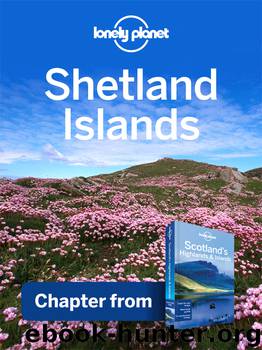Shetland Islands by Lonely Planet

Author:Lonely Planet
Language: eng
Format: epub
Publisher: Lonely Planet Publications
Romans & Picts
The origins of the people known as the Picts is a mystery, but they may have emerged as a confederation of northern Celtic tribes in reaction to the Roman invasion of Scotland in AD 80. Their territory (Pictland, or Pictavia) extended north through the Highlands and northeastern Scotland, from the Forth and Clyde estuaries to Orkney and the Western Isles.
Resistance to the Romans by lowland British tribes collapsed quickly, but the northern province, which the Romans named Caledonia (after the Caledones tribe), proved a tougher nut to crack. Eventually, the Roman general Agricola was able to advance along the eastern edge of the Highlands, supported from the sea by Roman galleys, defeating a vast army of Picts at the decisive Battle of Mons Graupius in AD 84 (thought to be near modern-day Inverness). Agricola went on to sail around the Orkney Islands, establishing for the first time that Britain was an island. However, the Romans were unable to press home their military advantage, and later retreated south of Hadrian’s Wall.
Much of what we know about the Picts comes from the Romans, including their name (from the Latin pictus, meaning ‘painted’, or possibly ‘tattooed’). The main material evidence of their culture is their fabulous carved symbol stones, found in many parts of northern and eastern Scotland, but whatever language they spoke has been lost.
The 7th century was a golden age for Pictish culture, when the disparate tribes were unified under the northern king Bridei mac Máelchú; most of the carved stones date from this time. However, Pictish unity only served to postpone the inevitable. The Picts held out against Irish and Anglian invaders until the end of the 8th century, but in 793 Viking marauders from Scandinavia began to raid the north and west coasts.
In the following decades, the northern Picts were decimated, and Caithness, the Western Isles, Orkney and Shetland were all absorbed into the Viking empire. The southern Picts retreated to Fife, before slowly being assimilated into the Gaelic kingdom of Dalriada. By the 9th century, Gaelic was the dominant language of the Highlands and the Celtic cross had replaced pagan symbols on the Pictish stones.
Download
This site does not store any files on its server. We only index and link to content provided by other sites. Please contact the content providers to delete copyright contents if any and email us, we'll remove relevant links or contents immediately.
The River by Peter Heller(2258)
Breath by James Nestor;(2232)
Sea Survival Handbook by Keith Colwell(2199)
Fatal Storm by Rob Mundle(2175)
Deep by James Nestor(2142)
Lonely Planet Australia by Lonely Planet(2034)
Iced In by Chris Turney(1960)
Discover Australia by Lonely Planet(1906)
Lonely Planet Maldives (Travel Guide) by Planet Lonely & Masters Tom(1800)
One Girl One Dream by Dekker Laura(1639)
Looking for a Ship by John McPhee(1630)
Chicken Soup for the Ocean Lover's Soul by Jack Canfield(1603)
Ten Degrees of Reckoning: The True Story of a Family's Love and the Will to Survive by Hester Rumberg(1601)
Lonely Planet Australia (Travel Guide) by Lonely Planet & Lonely Planet(1553)
South with the Sun by Lynne Cox(1542)
The Wave In Pursuit of the Rogues, Freaks and Giants of the Ocean(1507)
Diver Down by Michael Ange(1471)
Marlinspike Sailor's Arts and Crafts by Barbara Merry(1455)
The Golden Rules: 10 Steps to World-Class Excellence in Your Life and Work by Bob Bowman & Charles Butler(1434)
